Hell Strips
GW folks talk about them so I thought we could show and tell our Hell Strips. Mine is that long area between the street & the sidewalk, that place you can't water without it running off into the street or down the sidewalk. Any difficult area will do, those hot, bake in the sun areas where its survival of the fittest or maybe its a low spot in a ditch or a dry shade area full of tree roots, I've got one of those in the back still under "construction" where I'm still adding hardcore plants. We got some rain so its looking pretty good right now but its still only June.
These tough plants work well in the front H.S. where if gets hotter than blue blazes. I'm pretty proud of the mix & performance of these plants.
Mexican Feather Grass
Annual Gaillardia
Russian Sage
Flame Flowers
Purple Three Awn Grass
Plains Coreopsis
Gayfeather Liatris
Hairy Golden Aster
Rudbeckia hirta
Salvia Greggi
Blue Grama Grass
Muhlenbergia 'Flamingo' Grass
Heliantus annum
Dyssodia
Stipa capillaris
Antelope Milkweed
Prickly Pear Cactus
Damianitia
Purple Scullcap
Comments (78)
TexasRanger10
Original Author9 years agolast modified: 9 years agoHere is another photo of my sister's H.S. She lives in a small town in Kansas where there's a lot of these farmhouse type homes in town.
This is what typical small towns in the midwest look like. Very old fashioned and rural in feeling. She added that center path last year and has worked to bring this prairie garden out of chaos into a well balance natural prairie landscape, thats the challenge and I can relate 100%. Its not easy.
Related Professionals
Windham Landscape Architects & Landscape Designers · Ashburn Landscape Architects & Landscape Designers · Marco Island Landscape Architects & Landscape Designers · Simi Valley Landscape Architects & Landscape Designers · Brentwood Landscape Contractors · Jackson Landscape Contractors · Maple Valley Landscape Contractors · Lehigh Acres Landscape Contractors · Overland Park Landscape Contractors · Rockland Landscape Contractors · South Lyon Landscape Contractors · St. Louis Landscape Contractors · Tamarac Landscape Contractors · Waldorf Landscape Contractors · West Allis Landscape ContractorsTexasRanger10
Original Author9 years agolast modified: 9 years agoHere we are working out the problems in a weedy looking overgrown shady end of the east side of her H.S., sisters with the same disease -- Garden Fanaticism-- to the point of planting the whole place & talking about experiments & the many trials and errors we've encountered using local plants. Some we've tried that were small & compact in the wild grew huge & lanky in better garden conditions others have proved outstanding & garden worthy. We'd just got back from a prairie specimen finding excursion in the surrounding countryside of rural Kansas which I might add, is not very different than rural Oklahoma, there's a whole lot of "middle of nowhere" out there.
This post was edited by TexasRanger10 on Fri, Oct 10, 14 at 1:00
wantonamara Z8 CenTex
9 years agolast modified: 9 years agoTX, the family resemblance of your hell strips is amazing. Your sister's is a bit more "gentile', lacking the cacti. No danger gardening. I think it must be that amazing Kansas soil that makes everything look so lush. Even my coddled areas are more scraggly. That reminds, me I need to go hook up the 16' trailer and hoof in some more soil for my heavy fall planting. Too damn hot today. 100.
WoodsTea 6a MO
9 years agolast modified: 9 years agoTexasRanger, thanks for your encouragement about the grasses. The prairie dropseed and James' sedge in the photo were all nursery transplants. It was expensive to do it this way, about $200 for the 75 or so that I needed for my plan.
This was my first attempt at a planned planting of this scale, as well as with natives in general and also planting anything other than turfgrass from seed. I thought I might get discouraged by the several years it could take to establish everything from seed, so I decided to splurge on the grasses to give things a head start. So far I haven't regretted that. I'm planning to pretty much redo the whole yard eventually, and I hope I can do that from seed or cuttings as much as possible.
What you say about different forms of sideoats grama is interesting. So far mine haven't sent stems up so I'll have to wait to see which habit they take. One of my inspirations for this hell strip is a photo of the High Line in NYC that I saw in the Kingsbury/Oudolf "Planting" book. There's a combination of a Rudbeckia in flower, with little bluestem "The Blues" still looking very bluish, and in front some sideoats grama of the more lax/sparse form you describe. In this combo the sideoats looks great, perhaps because it's not the focus, but rather a sort of softening filter for the other plants.
TexasRanger10
Original Author9 years agolast modified: 9 years agowoodstea, the most difficult part for me has been that these plants are mostly to be had from seed so it makes it harder to plan and visualize the end result, a lot different than going to a nursery buying plants you can space out and see how they go together easily into a designated garden area. Lots of future editing is in order and moments of complete despair as the neighbors eyeball you as a crazy person, chaos is always looming as you worry you are making a mess instead of creating a landscape. Patience is key but especially editing. Its gets easier as time goes by and you end up with lots of seedlings which helps cover space and provide affordable material.
The sideoats is a fast growing grass, by season 2 you'll have a nice substantial sized clump and enough seedlings to make use of more the next spring if you need them. Same with Little Bluestem and others. Some grasses I have don't produce seedlings at all except maybe a few if I'm lucky, mostly its the muhly grasses fall into that category.
You were wise to purchase dropseed, its recommended since it takes a very long time to get a decent sized plant, thats how I would do it. I considered ordering some from SRG this fall but I'm finding it best to keep varieties at a minimum and make use of repeats instead for cohesion so I probably won't. I don't want to end up with a "specimen" garden or flower bed look so I'm working on correcting that in areas currently. I just moved a lot more seedlings this last weekend to get to that 40% ratio, sacrificing some flashier flowering plants in the process.
I love the gardens designed by Piet Oudolf using native grasses. Very inspirational and he's such a big noise with so many kudus of respect in landscaping that it has brought the lowly plants into respectability, its become quite a modern and sophisticated concept, very cutting edge and other types of gardens are even being considered outdated from some things I've read. It makes me laugh because of how dirt common these grasses are along the sides of the roads and no one gives them a second look around here.
wantanmara, its the "Wheat Capital of the World" where my sister lives or so the sign coming into town says. Its very rich and deep soil, she actually complains about it because stuff gets huge. Its a part of the midwest that didn't get blown to kingdom come in the Dust Bowl. Once it was all like that.
User
9 years agolast modified: 9 years agoGrimly, Tex, our East Anglia fens, deep friable topsoil from nitrogen fixing alder carr clearance, is/was also the cereal (and everything else) agricultural area of excellence....small mixed farms have been sucked up into a massive industrialisation of intensive farming techniques, owned by conglomerates - huge flat fields, no hegdes, no trees ....and in the easterlies which blow across the fens, no stability either. There are fields which are no longer viable and topsoil is drifting every year.....while polytunnels and giant greenhouses are springing up like malignant mushrooms. I am battling gigantic nettles arising from the nitrogen enhanced run-off which feeds our ditches - a sorry state of affairs which will not end well.....and now that the fracking lobby is growing apace, I have an almost visceral need to get and keep our small patch of land. Never owned a house, don't rightly care.....but the soil, the land....gardening is revolutionary
a2zmom_Z6_NJ
9 years agolast modified: 9 years agoTex, your sister's garden is just as beautiful as yours. It goes beautifully with the style of the house.
The High Line is one of my absolute favorite gardens in my favorite city in the whole world (I was born in NYC). The planting truly transports you and normally there is art interspersed which just enhances the whole experience. Who ever thought of transforming an abandoned railroad track into a garden deserves a medal.
Ruth_MI
9 years agolast modified: 9 years agoTexas - your HS is just awesome! I love the combination of textures and the cactus are so cool.
WoodsTea 6a MO
9 years agolast modified: 9 years agoa2zmom, I completely agree about the High Line. Possibly the best thing I have ever seen in a city, at least as far as built environment goes. I love the way the sense of the railway has been retained (and in some cases, the rails themselves). This is a pic I took there in 2010.
It's a good model for hell strips -- basically linear gardens with a requirement for minimal inputs of water, maintenance, etc.
TexasRanger10
Original Author9 years agolast modified: 9 years agoa2zmom, its all about texture, thank you for the compliment because this is what I'm working hard to achieve. I started this back in 2006.
woodstea, yep, thats it, we are on the same page. I love that, I especially love the tracks! I've looked at a lot of the ones he has designed. Its becoming the new garden approach, they are doing this on green roofs and taking out lawns all over, many large cities are doing it in industrial sections and other parts of the city for people to enjoy, kind of a reclamation and relief from all the concrete. Here where I live native grasses + native plants are being used more and more in the street medians, around the capital and other businesses etc, they glow in afternoon light and the textures are fabulous and its all low maintenance, its so refreshing and simple. Are you familiar with the photography of John Saxon? He's photographed prairie and meadow landscapes in various places across the country, he's so good at capturing the way the grasses catch the sun shining through them. He shot all the photos in the John Greenlee book on meadow gardening.
The later season native grasses in my own urban prairie attempt are just really starting up right now, its my favorite time of the year.
Here a few by Saxon Holt, there's many more online.
WoodsTea 6a MO
9 years agolast modified: 9 years agoTexasRanger, thanks so much for the Saxon Holt link. Lots of good photos there of different grasses in combination, very helpful.
My original idea was to use all prairie dropseed with only three or four wildflower species that would bloom in different seasons. At times I think this would have been a better approach, a lot simpler from a design perspective.
Part of the problem is that I keep finding new species to geek out about (like the downy gentian I saw in a local prairie preserve last fall), and then I want to find some way to wedge them into the hell strip planting.
TexasRanger10
Original Author9 years agolast modified: 9 years agowoodstea, I've become so geeked out I have insomnia thinking of the different combinations and possibilities at times. I keep working on different areas and I seem to always be stumbling across some new species I want to add. I checked out John Greenlee's book 'The Amercian Meadow Garden' (again) from the library recently for ideas and thats where I read the part about establishing your base grasses first, the lower growing filler grasses. Flowering bulbs, shrubs, annuals and perennials are 'sweeteners' so unlike me, you are definitely on the right track with the grasses you laid down. I seem to be working at it backwards trying to correct this but its coming along slow but sure.
You mentioned you are wanting to prairie a wider area, if you are anything like me, once you are hooked, you're really hooked and you will need more space just to get the feel of a prairie. Mine started out as a gravel and cactus garden all neat and tidy with plenty of space between everything. The bad thing was, after that was done, there was nothing left to do except maybe weeding. How awful.
That area of prairie dropseed you already did will be stunning once it fills in and blooms. My experience has been that many plants have found their own spots and surprises are always happening. It just sort of grows on itself so I don't really have a plan, I've pretty much just eyeballed it as it develops and made adjustments as I go along. I quickly learned common filler plants like low growing annuals that seed generously and short grasses are the key, specimen plants are just icing on the cake but too many focal plants end up creating conflict, simplification is better. I'm working on that too, its the hazard of wanting every plant I see. Filler plants are what ties it all together but I keep seeing unusual plants that tempt me. One good filler is annual helenium, commonly called bitterweed. I bought 3 plants one year and it seeds so well its now one of my good reliable workhorse fillers that gives me little bouquets of yellow spring to frost all over the place. Other aggressive low growing plants have become a blessing although in the beginning I was in a panic trying to weed them out because I was thinking in the old way and trying to maintain conventional "garden" neatness. This is not anything like when I had a conventional garden, its a lot more exciting because it evolves on its own over time.
I just purchased & sowed some ring muhly seed. Its a 3" tall grass that blooms in a haze of purple floating on the surface in fall. I can't wait to see how it does but right now they are seedlings in pots. I saw this picture the other night and went out and bought some deep red leaf, red blooming celosia because I think that deep red color is a winner among the sage colors I'm most drawn to. I can't grow red grain amaranth due to the size of my lot so celosia was a close mimic which I though was funny because its an annual I have always snubbed in the past as too common. I've changed into choosing plants for either texture, form or foliage colors, flowers are secondary or just an added bonus and not required to carry the weight. That pink grass is ring muhly, I ordered seeds the next day after seeing this.
wantonamara Z8 CenTex
9 years agolast modified: 9 years agoMost of the ring muhley that I saw out in NM staid fairly short and small. I like that since I walk through my grass. It is my "lawn", I also like tall too. for accents but bread and butter will be my curley mesquite and other short grass prairie plants. This should fit into this category.
I remember when I first started trading with you , and you were very cautious about plants competing and touching your cactus. TRue they were much smaller and more vulnerable back then. So I started sending the small plants that grew wild like the dysodia and 4 nerve daisy. Things that would not upstage or overgrow a cactus. Times do change us. It is all a process. Your garden is a beautiful example of balance and a xeric system.
TexasRanger10
Original Author9 years agolast modified: 9 years agoYea, remember when I was thinking about asking for permission to work on the planted areas at the local park up the street because my garden was done? And how depressing that was? I think some people approach their lot as a professional landscaping project for curb appeal or status but others are gardeners. I'm a gardener through and through, the idea of landscaping give me the hives. So are you + a land conservationist along with being an appreciator of anything natural or native and preserving it, thats why we get along so well -- ha! We speak the same un-conventional gardening lingo, two off beat ships in the storm.
I can absolutely relate to the undertones of grief I read in that last post of campanula--- "but the soil, the land". Where is it all going? So many things are turning into something I don't recognize anymore. By the way, frack is a fracking great cuss word. We have a lot of fracking around here and lately a lot of fracking earthquakes. We are becoming the fracking earthquake capital of the US and fracking is a prime suspect.
User
9 years agolast modified: 9 years agomuhly grass dammit - twice now, I have ordered seed (M.capillaris), sown and waited....on nothing. I am thinking that, like many plants, it needs to be fairly fresh and has particular requirements which are not met in a pot of John Innes 3 (my go-to bagged loam....NOT a multi-purpose summat or other). Am imagining it in front of our creek, backed by a cloud of hemp agrimony, fireweed and filipendula rubra (I have never had that pink stinks thing).
After spending this summer tiptoeing between pots (trying to grow enough plants to fill a couple of acres in a garden the size of a matchbox), sense has finally reasserted itself and, unless I am dealing with a handful of precious seeds, I am saying no more to this potting and pricking scenario. It is going to have to be seeds sown in situ (so obviously, only those common as muck things I can get my hands on in huge quantities), while relying on a mix of bents, fescues and clovers to provide a temporary cover to walk (and camp) on as we slash and burn (I am loving this method of clearing).
The upside to this walking about making hopeful little footscrapes will be surprises springing up all over the wood in the next few years....while a harsh selection process (and general attrition) weeds out the feebles and undeserving, leaving me with tough and beautiful plants. Of course, this could all go horribly wrong and I just get heaps more nettles but hey, I am in the land of the strange and unknowable now so all bets are off and all expectations muted.My son and daughter are deep in cacti and succulent territory and one of them (obviously my son) is immersed in that whole carnivorous thing too. I expect their wee obsessions to morph as their knowledge progresses.......while I am congratulating myself on a full-house of gardening enthusiasts, including past and present partners, all of whom have fallen under my corrupting influence to grow stuff.
dawgie
9 years agolast modified: 9 years agoGreat thread! I have a hell strip similar to many shown in photos, between the sidewalk and street in front of my house. Tried a lawn but it kept drying out and dying, and too hard to water. Then I tried ice plant but it apparently got too wet at times. Finally just covered with heavy mulch and planted prairie dropseed, some of which thrived but others not. So I recently moved the dropseed to a better drained location, and filled the strip with pink muhley grass, which I think will be the perfect solution. It gets so much sun in that spot that it should flower spectacularly in late summer.
I like the way many of you have intermixed other perennials, so I might try that as well. We also have a huge deer problem, so anything I plant has to be unpalatable to deer.
daisyincrete Z10? 905feet/275 metres
9 years agolast modified: 9 years agoI didn't know what a hell strip was, until I read this thread.
What a great idea to plant the boring bit by the road.
Everyone who walks along must enjoy it immensely.
The public road in the front of my house is more of a wide footpath. Wide enough for a laden donkey to walk up.
Not that there are many donkeys now, more 4 by 4s. They can't drive up the steps, so it is only foot traffic now.
Mainly my neighbours going down to their allotments, which are below the village.
I have put some pots along the edge of the path.
They are mainly planted with strong colours which I feel would be a bit much in the main garden which is behind the house.Campanula, when are you going to write a book?
Every time I read your comments, I wish that you would. I would buy it.
DaisyWoodsTea 6a MO
9 years agolast modified: 9 years agoSpeaking of geeking out on plants, have you seen the Range website at tarleton.edu?
http://www.tarleton.edu/Departments/range/Home/home.htm
Its focus is range ecology (for instance, frequent mentions of palatability), but there's a lot of info here on plant ecology in general. I've spent quite a bit of time reading the tallgrass and true prairie pages.
I've got a slimflower scurfpea plant in my hell strip that I first learned about on this site. Since then I've seen it out on a Kansas prairie preserve (photo, taken last weekend). It's sort of a sprawling thing, not perhaps ideal for a small garden, but I like having it there. Who knows, maybe this species was growing where my yard is before settlers arrived in this area.
WoodsTea 6a MO
9 years agolast modified: 9 years agoOr whoops, that's a Baptisia. Thought I had a picture of the scurfpea (which is even more sprawly), perhaps not.
wantonamara Z8 CenTex
9 years agolast modified: 9 years agoAll that red would be welcomed in my back garden, front garden, side garden roof garden, window box, vase on the kitchen table,……….
Woodstea, you might like delving into this site It deals with land issues a tad larger than mine but the ideas behind it fascinate me. Sorry for getting off topic. They use Holistic land management practices and address invasiveness in another light of ecological balance.
They have bitten in to a very controversial subject below. I am a chain sawer of cedar . I fight thistle , KR bluestem and cow birds. I am a bit confused by this but the points they bring up are interesting and worth thinking about. Is invasion a instrument to address change in biodiversity and in reaction to stress of the land. Beneath the video is another interesting link. The whole site has interesting peeks into another world.
They have interesting video of Habitat restoration on a ranch in Northern mexico. A very interesting site with hours of digging for me.
Here is a link that might be useful: Invasion Biology on CircleranchTX
This post was edited by wantonamara on Wed, Jul 30, 14 at 16:36
TexasRanger10
Original Author9 years agolast modified: 9 years agodaisyincrete, that looks Mediterranean, is it? Simply gorgeous! I love the pots, the walls, the steps, the plants, well, what can I say, I love it all.
woodstea, thats weird, I ran across that tarleton site just recently when trying to ID a grass that turned out to be Western Wheatgrass, it will grow in shade. I have been plowing through it since.
I've never seen the Circle Ranch site, I got immediately hooked in to "Aoudad The Bogus Boogey Man" and will finish reading it later. "This may offend some people"---a sentence like that will draw you right in every time.
campanula, I found slash and burn is one of the most satisfying projects in gardening because its so determined and once started, its all consuming. I had a lot of satisfaction ripping everything out in 2006. Not that I actually did any burning but I did a lot of slashing, ripping & digging. It was downright cleansing.
wantanamara, I don't think that website is off topic at all and its got me thinking. In the old days when I used to buy nursery plants and do the typical garden thing, I never thought of these things. If bugs attacked, I sprayed, if it was dry, I watered and I strove for perfection and neatness. It was all about appearances and plant lust $$. I was separated from the earth back then even though I had my hands in soil all the time. Now it all seems very artificial, contrived & commercially driven, for lack of a better description from this look back point.
In my experience, once I started an interest in native's, especially the grasses, I became acutely aware of the surrounding countryside in a way I never did before & what we are loosing rapidly by the acre. I never gave it thought before. Now I am concerned & sometimes outraged over things like water waste, tree encroachment, chemical use, prairie dog eradication, loss of prairies etc. Instead of just shopping for new plants like a plant-aholic, combing catalogs for pretty stuff and "gardening" I got off into these sorts of ecological issues because its only an eyelash away, once you get into this, thats where you naturally end up almost right off the bat.
Another very nice thing is that people now stop by my house all the time and talk now since I removed the lawn and the typical landscape and replaced it with this native "mess". It opens doors for friendly conversation because its different and stands out among all the deep green, sprinkler system, well kept mowed lawns with deep green shrubs & flashy nursery type plants surrounding me. People usually say it reminds them of something from their past, a place where they once lived & nostalgic things like that. They enjoy seeing it & many have driven here to see it after hearing about it from someone else. I was thinking of what campanula wrote when she said they'd all talk when she was working on her front area, its always like that. People are drawn to plants and a hell strip (despite the name) is quite friendly, people will stop to chat when you have one. I just wish my street also had a median like some streets do - that would be a blast to work on.
WoodsTea 6a MO
9 years agolast modified: 9 years agoI've talked to more neighbors this year while working on the hell strip (and some cover cropping I did just before that) than I did in the twelve years previous.
They don't seem to stop to chat as often when you're mowing, weed-whacking, rototilling, spraying herbicides...
TexasRanger10
Original Author9 years agolast modified: 9 years agowoodstea, Just wait until that P. dropseed starts blooming in a haze and turns colors this fall, people will really be looking & asking you about it. Its one that stays nice all winter too. Do people comment "wow! no mowing" ? Seems in real life, no one likes to mow. I get that one a lot.
If I'd wanted a year to be transplanting N. grasses all over the place I couldn't of picked a better summer. It keeps raining. We go about 3" yesterday, its cool, it doesn't seem like summer at all, in fact its creeping me out.
a2zmom, The 'Rotstahlbusch' switchgrass was splayed out horizontally from the center looking like crap again so I dug up another one between downbursts of rain, well not exactly, I finished up in the rain. Some things you just can't stand looking at, I was a wet mess but at least its gone. It was kind of sad, the diameter must have been at least 2 feet. First I whacked it down with grass shears then dug it out in sections and now I've got a big bucket full of good sized rooted plant divisions, seems a shame to toss them. If they could be planted on the high end of the property where it stays dry they would probably do fine (even if not red in fall like the info says) but they were planted at the far end where the water runs downhill. So far now, I've pulled out 2, I have one left to go. All those divisions would be enough to plant a big area, I wish it was a different grass. The roots weren't all that deep and they split up pretty easily and look ready to plant in case you ever want to divide yours.
wantonamara Z8 CenTex
9 years agolast modified: 9 years agoTx ranger, You could list it on Craigs list or on the OK exchange form or put it out with a for free sign. I hate composting plants,but I do. There are no passerby's out here .
dawgie
9 years agolast modified: 9 years agoHere's a shot of my recently replanted hellstrip. The main feature is a row of Pink Muhley grass, which I moved from another spot in my yard. I interspersed the Mulhlys with various perennial divisions from my yard, including black-eyed Susans, orange butterfly weeds, blue fescue, Gaillardia, purple coneflowers, and various sedums and ice plants. Hopefully the Muhleys will recover from the transplanting enough to flower this fall, but I don't expect much out of the perennials until next year.
Here is a link that might be useful: hellstrip
WoodsTea 6a MO
9 years agolast modified: 9 years agoHere's a shot of the prairie dropseed in my hell strip that I took this morning. The tallest of these have easily reached 3 feet. I'm wondering how this will be in a couple of years when they've really filled in, hoping it won't be enough to impede the view when backing out.
I've noticed that a few sedges that I planted in the full sun part of the strip seem to be doing just fine. I'm thinking about moving some of the dropseed elsewhere in the spring, and planting more sedge to keep the overall profile a little lower.
TexasRanger10
Original Author9 years agolast modified: 9 years agowoodstea, I think its gorgeous. Three feet? I didn't realize it got that tall, just think how pretty it will be in winter with those dried seeds.
I've just about decided you really cannot have too many grasses unless its bermuda or lawn. I've been adding bluestem all over the place so next year it will be Little House on the Prairie here. I have two pots full of small ring muhly that I plan to plant when it cools down a bit. We are 100 degrees currently and very dry. I got ya beat in hell strip height on only one grass and the Russian Sage, everything else is within about 3'. See photo below. The big blue tall one is 'Flamingo' muhly and it will be a cloud of purple in a couple weeks. Somebody knocked over the gallardia behind it, I went out a couple days ago and wondered why it looked so bad, there it lay detached like a big tumbleweed. I think it was assaulted.
The grass cut off in the photo is Muhlenbergia riverchonnii, its an Oklahoma native. Its in its full smokey purple glory right now.
Oh, I guess that Cowpen daisy plant at the end (a bit of pure out-in-the-country there) would be taller too. Those are common roadside plants around here.
TexasRanger10
Original Author9 years agolast modified: 9 years agoTexasRanger10
Original Author9 years agolast modified: 9 years agoHere is a picture that shows the Russian Sage. I kept the height shorter by the drive way but I don't care about the height further up. You might try just using the sedges close to where you have to back out of the drive. I think maybe some housing areas might have height restrictions but I haven't run into any problems here. That R. S. is over 4 ft tall and wider than that. The neighbors drive is way over on the other side of his yard so no problem there.
WoodsTea 6a MO
9 years agolast modified: 9 years agoI sure like the pale green of that cactus. And the low spreading form and color of that Muhlenbergia riverchonnii (at least what I can see of it).
My strip is only about 30 feet long. I've found that it's actually the middle and far end of the strip that's most important to keep short. The neighbors beyond that all have fairly thick trees in their strips, so it isn't always easy to see someone coming until they are past the last one and then I am looking over the far end of my strip.
My other concern is that my driveway is shared, so there's someone else backing out that isn't particularly a native plant enthusiast (yet).
katob Z6ish, NE Pa
9 years agolast modified: 9 years agohaha, love the do ya like yellow corner!
dawgie- that strip already looks great even before the new stuff grows in. I wish my muly grass did as well, I think it's just not hot enough here.
The backlit prairie dropseed picture is like twenty reasons to grow grasses all in one picture, looks great. There's a mass planting not too far away, but I don't like the smell of the flowers so that always turns me off to it.
TexasRanger10
Original Author9 years agolast modified: 9 years agoThanks Kato, yellow seems to get besmerched a lot around here. My husband has a couple more new lines he uses a lot when we walk around my "parking lot/industrial plantings" since I told him about some of the opinions about yellow. A couple comments struck him as repeatable so he gets to be funny, any chance he has to do this is, he does. We officially call it The Parking Lot now.
I just redo-ed a whole hill in little bluestem out back after seeing that mass planting of prairie dropseed of woodstea's. See, we get inspiration from others...or maybe its just plant envy? The whole hill is now 'The Blues'. I'm eyeing a couple other areas to do mass plantings.......... but the hell strip will stay as varied plantings. I mean heck, I'd really miss picking trash and leaves out of those cactus and cut back Russian Sage each winter if I did it all grass. One function of the Hell Strip is to keep stuff from blowing on down the street, isn't it?
WoodsTea 6a MO
9 years agolast modified: 9 years agoWow, a whole hill in The Blues, that will be spectacular. How far apart did you space them? Will you underplant anything among them?
TexasRanger10
Original Author9 years agolast modified: 9 years agoI spaced them so there is space between the plants, I guess about 1.5 ft. I like bluestem to look like exclamation marks, the way they always look in the wild. There are a couple large blue cactus clumps, some blue-leaf missouri primrose, grey hairy yellow aster, a pink yucca, two blue yuccas, zexmenia & a couple other wild things around the area & a still immature butterfly bush behind the grasses. I need a backdrop in front of the ugly wall behind all this. I am thinking of something green for contrast but its shady there all summer. The only thing I have come up with is holly shrubs since they will grow in shade. Its not my most photogenic area because there is also a metal shed next to it in the back corner of the lot.
These bluestem are volunteers I moved from the plants I originally bought at Santa Rosa. I took the original grasses out this spring because they were planted in deep sandy soil. The plants were so "happy' the roots cut through that soft sand like butter, they got huge & then flopped from the weight of the numerous bloom stalks each year looking like thick tussock grass rather than bluestem. The soil bakes hard and dry in this new spot so they should look more like they are supposed to.
Last winter I bought a large mixed packet of wildflower seeds & scattered them about. A few came up here and there but back among the bluestem I noticed there is a single Moss Verbena and I have to tell you, its a perfect non competing native to have among grasses because its such a delicate plant and has small purple flowers. I'm hoping it naturalizes next year in that spot.
I am considering Verbena bonariensis for next year, I have a couple and plan to scatter seed among some other grass this fall. Its a see through plant and all the photos I've seen of it planted with grasses look great especially in fall. Light airy plants look good among grasses.
TexasRanger10
Original Author9 years agolast modified: 9 years agowoodstea, are you there??? I planted a packet of Water-Wise mixed seeds mid winter. The one that is blowing me away is Verbena tenuisecta (Moss Verbena). I have it coming up on my new hill of mostly Little Bluestem 'The Blues' I transplanted this summer. Its a really airy plant that sort of unobtrusively puts out long stems that makes make their way among the grasses continuously blooming with dainty pink/purple flowers. It has a real "prairie feel" about it, the leaves are very small and dainty and its shorter than the grass adding these bright purple flowers which go so nicely with the blue of the grass which is starting to turn shades of purple--a match made in heaven.
I googled it and most sites say its a perennial but if not hardy will naturalize from seed. Maybe that is based on the zone? The packet says perennial. The weird thing is its not acting like a thick ground cover like in most of the photos on Google. I found an annual type (see link) and this is more what it looks like, that site says its an annual. I'm confused. The seed packet is one I bought locally here:
Botanical Interests -- Water Wise Mix.
I can just imagine it among that orangey fall color of the Prairie Dropseed you have on your H.S.
I ordered a Big Bluestem 'Red October' from Santa Rosa Gardens, its on a backorder for spring. Check out that red! I'm putting him down on the strip at the end by the street sign where its lean and mean so he doesn't flop.
User
9 years agolast modified: 9 years agoThat little verbena is often grown for hanging baskets as a bedding annual in the UK...but you are right, it will look sensational in your garden. I have always fancied sand verbena (V.abronia) but that would be pushing my luck....but I do have VB which does seed around but is easy to pull and true, it does look lovely with grasses....I have a massive weakness for tall and airy perennials. I am also trying a new verbena this year - v.stricta, aka hoary verbena....will hopefully pair with rattlesnake master (love that name)...on the dry and sunny western edge to the woods (where the beehives are).
TexasRanger10
Original Author9 years agolast modified: 9 years agoI planted some V. bonarensis (sp?) and think it looks good with grasses too. I am now on lookout for wild verbenas. I don't care for that common one sold as a nursery bedding plant but these airy ones or see through plants are a different matter. I have a catalog that sells the Hoary Verbena, think I will put that on my list. I'm also getting Spectacle Pod (Dodecatheon pulchellum) and a couple others.
I have sandy soil which the Sand Verbena likes, says "difficult to germinate, try scarification". There are 2: A. fragrans and A. villiosa. Heck, may as well add those too, I'd like either one.
These all say to fall sow.
wantonamara Z8 CenTex
9 years agolast modified: 9 years agoOOOH, I just picked up a Rubber Rabbit bush and a Leucophyllum candidum "Thunder cloud" for my hell spot. No street but definitely hell to there on a summer afternoon. It is smaller and a darker purple than the normal Leucophyllum. shorter , more compact and tiny ruffled leaves. It is for an area that get 10-15" of rain so it will do fine on my slope of limestone rubble and rock..
wantonamara Z8 CenTex
9 years agolast modified: 9 years agoTX, I planted some of the V bonarensis in the middle of the summer and it did not blink or miss a stride. It is tough. I did give it some non xeric garden soil to retain some moisture. I have been treating my salvias that way lately and I think some of them are liking the extra compost o over the granite sand.
WoodsTea 6a MO
9 years agolast modified: 9 years agoTexas, thanks for the verbena suggestions, I'll take a look. I see a warning on the MO Botanical Garden page on V. bonariensis about possible invasiveness, though I suppose that would apply to a more humid climate than yours.
Here's a shot out towards my HS just now. We've been dry for several weeks, then this all of a sudden. (The sparsely vegetated area on the left, btw, is a rye/vetch mixture I planted recently as a winter cover crop.)
I've mostly liked the prairie dropseed in the HS, but I often think that I should have kept it away from the sidewalk more and put shorter things (sedge, for instance) in front of it. I've found that I'm less crazy about dropseed and more crazy about sideoats grama as time goes on, so I may mix more of that into the HS as well.
Here is a link that might be useful: Verbena bonariensis at MoBot
TexasRanger10
Original Author9 years agolast modified: 9 years agoWantanamara yer whole place is one wide hell strip. Cool plant buy. Make room for 5 Apache Plumes, the little guys are in a quart pot. There is a patch of V. bonarensis up the street thats been there for years. I got mine from one she yanked out of the ground and I came home and plunked it in a few years ago. I don't think it realized it had even been relocated. I have sort of ignored but left it every year and it behaves but I have pulled the few volunteers. Then I saw a grass planting recently online and this same subject came up here on the forum so I went out and moved mine to the grassy area so it now has a purpose. I've got three starts out there.
woodstea, do you like the blue grama grass? SRG still has some of the 'Blonde Ambition' left for $2.99 each and if you order more than 5 (I think its 5) they give you an additional discount. I bought 8 of them and one ended up being free with the discount. I also applied these three discounts: Monkey, My5, Fall10 and got another $15 off plants that were marked down 75% and the shipping is only $5.oo.
Its a shorter well behaved grass that has the seeds all summer into fall. I like the regular plain blue grama too, its even shorter, they also have that. It likes dry unlike the carex which usually likes moist.
WoodsTea 6a MO
9 years agolast modified: 9 years agoI had originally looked at B. gracilis 'Blonde Ambition' for inclusion in the HS, but I'm not sure the height in flower would be much different than the dropseed or sideoats grama. I've seen some lovely pictures of it, especially in front of some contrasting taller plant -- such as late season little bluestem.
I do have at least once sedge plant -- it's supposedly Carex jamesii, but I'm not convinced yet -- that got planted by mistake in the full sun part of the strip. It's been doing great, but I can see how it could have more trouble in a drier year. The size though would be just about perfect in front. It's a foot tall at most and the culms are supposed to be shorter than the leaves. I only wish it contrasted more with the dropseed: bluer, yellower, etc. Along the street side (east) these would get some afternoon shade from the dropseed by midsummer.
We had another downpour today, perhaps a couple of inches that came down all at once. The dropseed stems are splayed all over the place now. At times like these I wish I had removed a few inches of the subsoil and mixed in coarse sand and pea gravel down to 8-12". At the time it seemed like too much work, plus I was worried about disturbing a buried communications line. I am still apprehensive about how these plants -- especially the butterflyweed -- might survive a snowy winter with the extra load from the plowed street snow.
TexasRanger10
Original Author9 years agolast modified: 9 years agoThe regular blue grama forms a 6" tall to 12" wide tight tuft. The stems are very thin and stiff with those little eyelashes on top, a see through deal. They go dormant if it gets dry in summer but then green up if it rains. I sort of like the wheat color myself though as a color and mine are usually a mix of wheat and green in summer. Its short enough to be used as a lawn with no mowing unless you want to cut off the seeds for a lawn look.
'Blonde Ambition' is one I haven't tried but wantanamara said it blooms heavily all summer for her, she's got harsher, more challenging soil conditions than me. I especially like blue grama here and there on the borders but honestly, I don't have a problem with grasses spilling over onto the edge of the sidewalk and I think yours look good in spite of being a bit soggy in that photo. Lucky people are getting rain, we are still in the 80's and bone dry here. wah.
I have lots of plants that spill over and onto the sidewalk somewhat and I like the ones that come up in the cracks too. Each year I intentionally put seeds in the cracks, it makes a natural more wild prairie look which is what I am wanting.
I did have to take out 2 sideoats grama on the slope that goes downhill toward the sidewalk. It stands straight up but as the plant increases in diameter by year 3 they tend to lean downhill on the side toward the sidewalk, its so tall its a bit much and I didn't like the way it looked. I replaced them with 'Blue Heaven' bluestem and massed a couple areas elsewhere. They don't do this when growing on the flat ground, there they stand straight up. I love those. They are the fastest to reach mature size of all the native grasses I've planted.
Thats a blue grama in the corner and a smaller volunteer close by. I don't get lots of volunteers, just a few. This is good because its not a long lived grass and it replaces itself nicely.
TexasRanger10
Original Author9 years agolast modified: 9 years agowoodstea, I got the package from SRG yesterday. The 'Blonde Ambition' is much taller in every respect, blooms & leaves, than the plain blue grama. I regrouped and chose a different spot to plant the 8 I ordered. If you want a shorter one, choose the unnamed variety or get seeds. They shipped the 'Red October' big bluestem! They must have had one left because the website had it listed as only available in spring 2015. Its already got a lot of red on it and a good set of big roots.
WoodsTea 6a MO
9 years agolast modified: 9 years agoI do actually have a bit of blue grama that I grew from seed scattered in July. One of the plants has stems that are anywhere from 24-30" long, but they've flopped over so I don't notice it much among the other plants. We'll see if it holds its shape a little more as it fills out, but I probably won't keep if it there if it will always be floppy.
I like your idea about sidewalk cracks. Eventually I hope to replace my sidewalks with permeable pavers, but in the meantime there are a number of broken places that each year are colonized by various weeds, spurge in particular. Perhaps that moss verbena would work in that setting.
greenhearted Z5a IL
9 years agolast modified: 9 years agoTexasRanger, do you have a picture of the Muhlenbergia riverchonnii? I see you mention that it is the grass that is cut off in the photo you posted. I love your style and your sister's too!
TexasRanger10
Original Author9 years agolast modified: 9 years agoI haven't shot any this year, this picture was shot in October of last year when I had 3 of them planted together. I had to dig 2 up and move them because the city couldn't find the water meter and I got a notice, they are still recovering the transplant. The grass gets about 3ft wide. It looks all crowded in the photo due to the angle of the shot, there is a sidewalk on the other side of the grasses and a path beyond you can't see as well back there where the big green cactus and Little Bluestem are. That is a very large Russian Sage in the right corner of the photo. The taller grass just starting to put out inflorescences us Mullenbergia 'Pink Flamingo' which is a cross between Gulf Muhly and Muhlenbergia lindhemeirii that was discovered. High Country Gardens sells it.
The grass at the bottom is Purple Three-awn. I have been replacing some Mexican Feather Grass with these since they bloom longer.
The dark creepy in the background is next door where a huge pin oak keeps the whole yard in darkness and nothing will grow, its nearly bare ground with a bit of struggling grass, quite hideous.
TexasRanger10
Original Author9 years agolast modified: 9 years agoHere it is a bit later, shot November 11 when the 'Pink Flamingo' is at its peak of purple. The M. Riverchonni is turning orange, its in its prime in mid August here when its a dusky deep purple and the flamingo is still very upright with deep steel blue rolled leaves.
This post was edited by TexasRanger10 on Mon, Oct 6, 14 at 17:10
greenhearted Z5a IL
9 years agolast modified: 9 years agoThanks for digging those out, TR. Stunning!
Gosh, you're right that darkness is such a stark contrast to your sun lovin' garden. It looks very ominous back there, brooding. But I do love me some oaks!
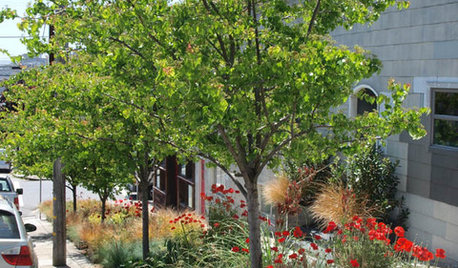

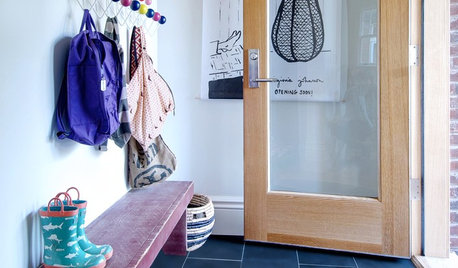

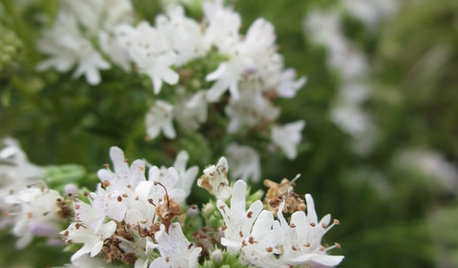
















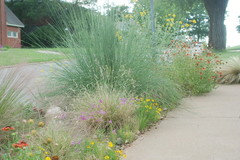
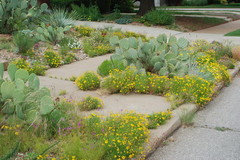
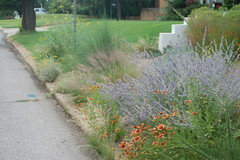



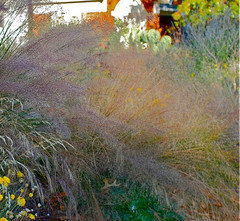
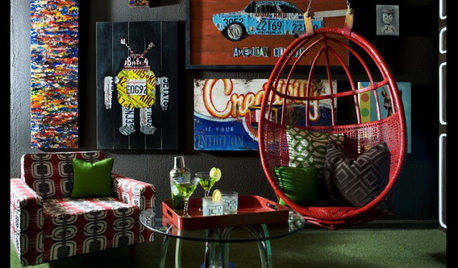
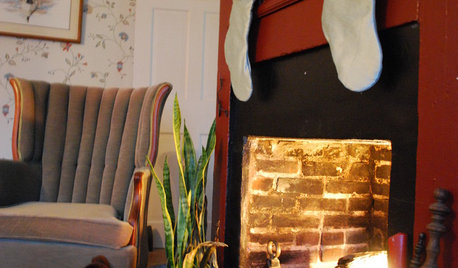
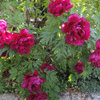
TexasRanger10Original Author